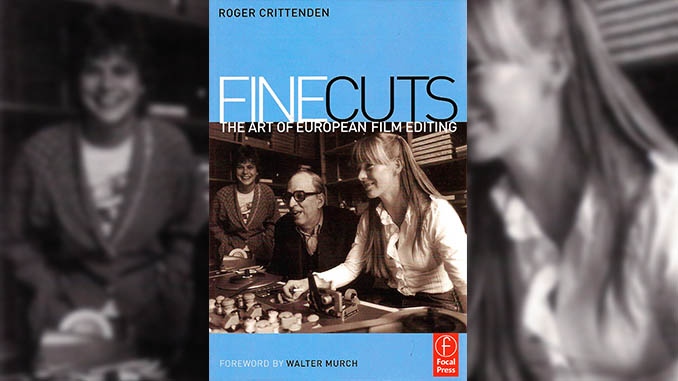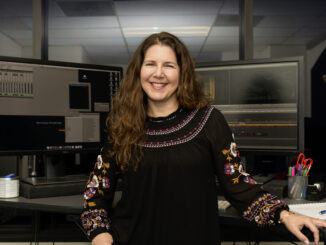
by Ray Zone
Fine Cuts: The Art of European Film Editing
By Roger Crittenden
Foreword by Walter Murch
Focal Press
400 pps, paperbound, $34.95
ISBN 0-240-51684-2
The diversity of techniques and point of view in Roger Crittenden’s new book on European film editing is fairly astonishing. One can also justly ask the question, “Is there a difference between editing styles of American and European motion pictures?”
Some of the more than two dozen editors interviewed and represented in this book attempt to answer that question.
Yann Dedet, who has edited the films of François Truffaut, Dusan Makavejev and Maurice Pialat, among others, offers some highly cogent observations on the subject. “What seems to be apparent in most of American Cinema is a very important rational thinking at work,” says Dedet. “Everything has to make sense and be precise.” Dedet notes that the American ideal in cinema “is an infinite continuity of pleonasms [emphasizing the obvious].”
In European cinema, however, Dedet observes, “You can sometimes see un plan pour rien [literally a shot for nothing] different, elsewhere, out of the movie, but which is in fact the movie… There is no story, no thesis to defend, there is no purpose, just doing music, letting time flow.” When one considers the tracking shots in Alain Resnais’ Last Year at Marienbad (1961) or the extended sequences in Michelangelo Antonioni’s films, this comment makes a lot of sense. There is something in the way that many European films breathe, editorially, on a temporal level that is definitely unhurried, a sense in which an individual motion picture is allowed to find its own rhythm unconstrained by three-act structure or the need for momentum.
Takis Yannopoulous, who has edited film for most well-known Greek directors, makes a similar observation. “I believe that the demands of editing are different in an American film,” he says. “With both English and American editors, I noticed that directors usually say, ‘boom, boom, boom’; they give a tempo regardless of the dramaturgical requirements of the scene. The cuts have to change every 60 or 80 frames, perhaps even faster.” A European director, on the other hand, “leaves silences in the film and creates plausible and realistic situations, aiming at the involvement of the audience,” according to Yannopoulous. The silences left intact in a film, he believes, “allow the spectator to recognize things which are not said or not dramatized.”
Roger Crittenden has juxtaposed individual interviews with essays and critical arguments by some of the directors who worked alongside these editors.
Crittenden, of course, is an editor himself and, like many of the contributors to this volume, “entered the cutting room by accident rather than intention” and only chose editing for a career after his initial experience. “[Editors’] innocence at the outset, even their naivety, may in some cases have made them better candidates for the job since, in my opinion, a lack of preconceptions gives the aspiring editor certain advantages,” Crittenden writes.
Another advantage for nascent editors may be a fine arts background in music and painting rather than film or TV. This was the case with Agnès Guillemot, who has edited films for both Truffaut and Jean-Luc Godard. “I did not feed on films when I was young,” recalls Guillemot. “I read a lot and went on to study philosophy.” Like several other editors included in this book, Guillemot may have been most influenced by music. “I was a student in Poitiers. Then I discovered music,” she says. “When I saw a film on Roberto Benzi, who was a child prodigy conductor in the 1950s, I said to myself, this is what I want to do. Not with music––with what I did not know––but I would find out.” Guillemot prepares her dubbing sheets using music paper on a horizontal format rather than the typical vertical style.
“I discovered music through the films of Rainer [Fassbinder] and later through Werner [Schroeter], beside my own experiences,” says Juliane Lorenz, who has edited films for both of these prominent German directors. “When I saw Death in Venice, of course I started to hear Mahler. Mahler from dawn to night,” observes Lorenz. “Without loving and knowing something about music, you can’t be an editor––you have to have a musical ear.”
In his illuminating Foreword to this book, Walter Murch, ACE, MPSE, CAS, observes that between the first motion pictures created in 1889 and “around 1903, at age 14,” the movies “unexpectedly discovered the intoxicating and almost sexual power of montage. What emerged out of this adolescence, as a butterfly out of its chrysalis, was cinema.” Murch provides a simple equation for this “fruitful paradox”: Motion Pictures + Montage = Cinema. The natural reticence of motion picture editors to stay in the background, notes Murch, “is beginning to disappear.”
“What seems to be apparent in most of American Cinema is a very important rational thinking at work.. Everything has to make sense and be precise.” -Yann Dedet
Crittenden has juxtaposed individual interviews with essays and critical arguments by some of the directors who worked alongside these editors. Essays by Godard and Truffaut, for example, usefully bookend the interview with Guillemot. For anyone who has enjoyed the French New Wave, Italian Neo-Realism or the films of Andrei Tarkovsky or Ingmar Bergman, Crittenden’s volume will be essential reading.
Michal Leszczylowski edited The Sacrifice (1986), Tarkovsky’s last film, and reveals what it was like to work with one of cinema’s most distinctive voices. “I enjoyed every minute of it. Those endless analyses of the images, the light, acting, contrast, camera movements,” he recalls. “Tarkovsky was always in doubt whether what was done was good enough. Now I know that only debutantes do not doubt––they know. The great directors I have worked with have in common the ability to doubt.”
Bergman also had this quality of searching doubt in his work. Leszczylowski tells about an interesting moment involving the two directors. “Tarkovsky and Bergman never met, but once, at Film Huset in Stockholm. They saw each other and turned and ran away. Bergman said, ‘Tarkovsky freely moved in the room, where I succeeded only to open the door a little to look in.





